NCERT Class 7 Science Chapter 14 Electric Current and Its Effects Solutions to each chapter is provided in the list so that you can easily browse through different chapters NCERT Class 7 Science Chapter 14 Electric Current and Its Effects and select need one. NCERT Class 7 Science Chapter 14 Electric Current and Its Effects Question Answers Download PDF. NCERT Class 7 Science Solutions.
NCERT Class 7 Science Chapter 14 Electric Current and Its Effects
Also, you can read the NCERT book online in these sections Solutions by Expert Teachers as per Central Board of Secondary Education (CBSE) Book guidelines. CBSE Class 7 Science Solutions are part of All Subject Solutions. Here we have given NCERT Class 7 Science Chapter 14 Electric Current and Its Effects and Textbook for All Chapters, You can practice these here.
Electric Current and Its Effects
Chapter: 14
NCERT TEXT BOOK EXERCISES
Q.1. Draw in your notebook the symbols to represent the following components of electrical circuits: Connecting wires, Switch in the ‘OFF’ position, Bulb, Cell, Switch in the ‘ON’ position and Battery.
Ans: Draw in your notebook the symbols to represent the following components of electrical circuits:
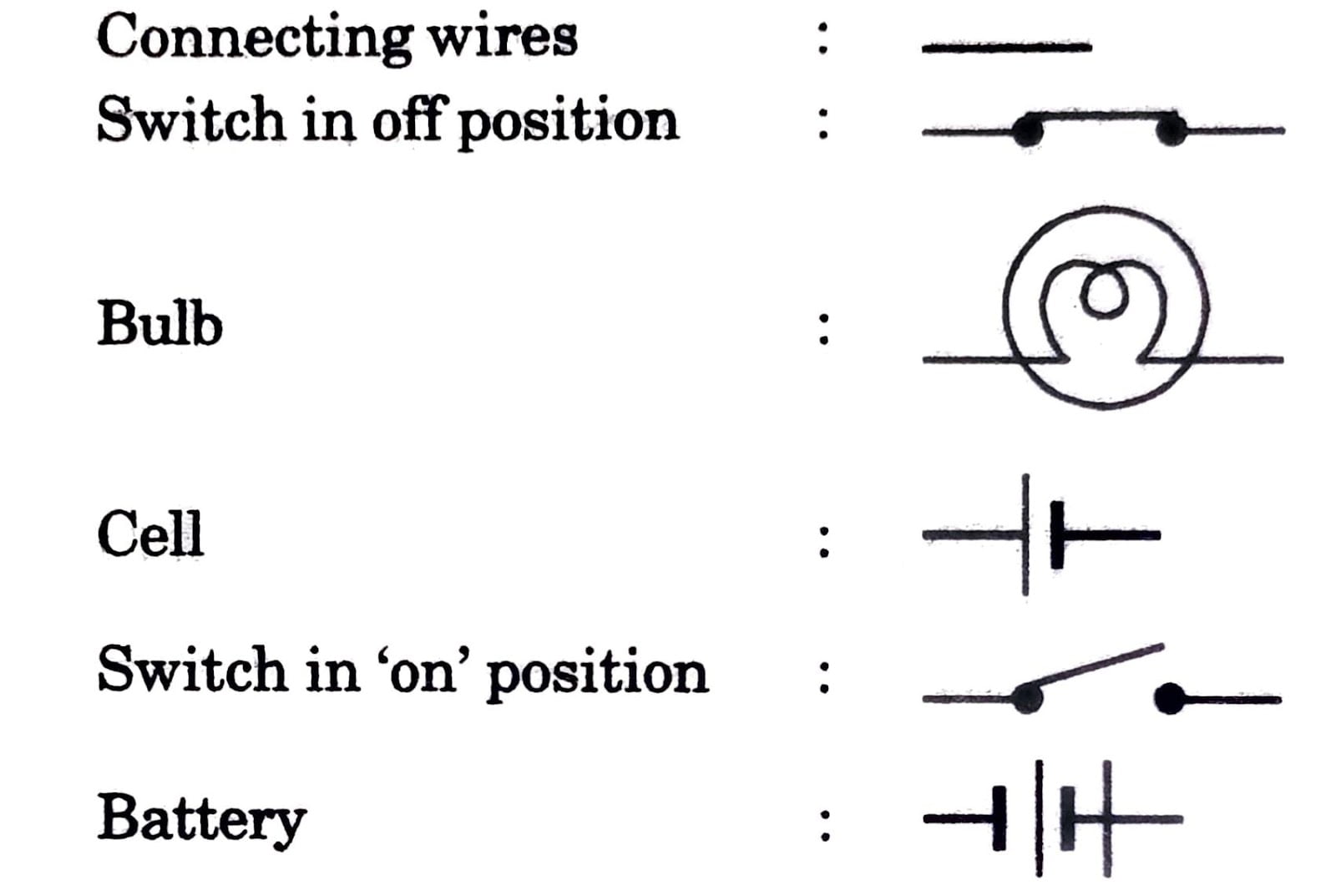
Q. 2 Draw the circuit diagram to represent the circuit shown in Fig. 14.21.

Fig. 14.22.
Q. 3. Fig. 14.23 shows four cells fixed on a board. Draw lines to indicate how you will connect their terminals with wires to make a battery of four cells.
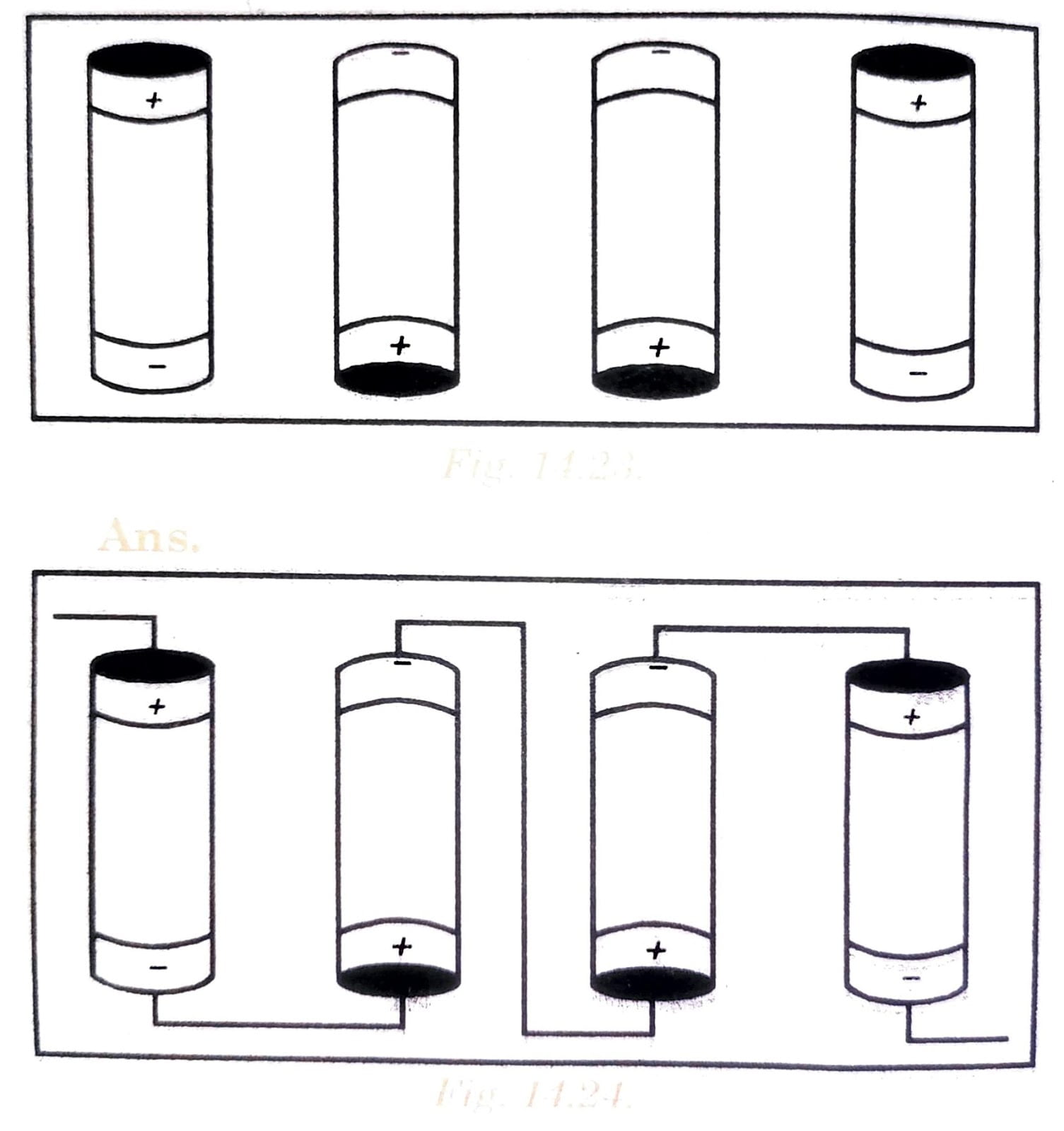
Q. 4. The bulb in the circuit shown in Fig. 14.25 does not glow. Can you identify the problem? Make necessary changes in the circuit to make the bulb glow.
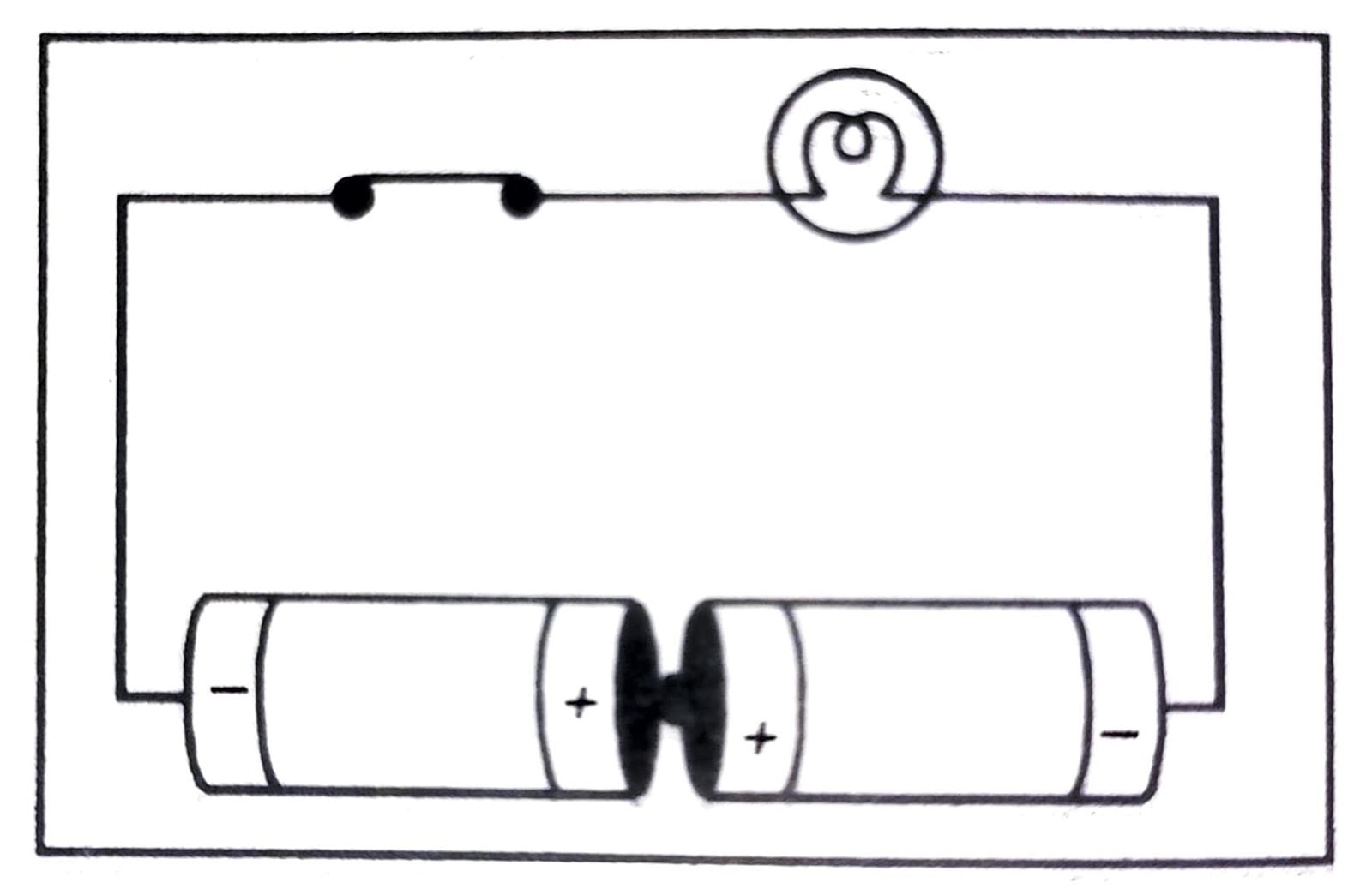
Fig. 14. 25.
Ans: Problem in this circuit is the combination of two cells. In the circuit positive terminal of one cell should be connected with negative terminal of other to make the bulb glow.
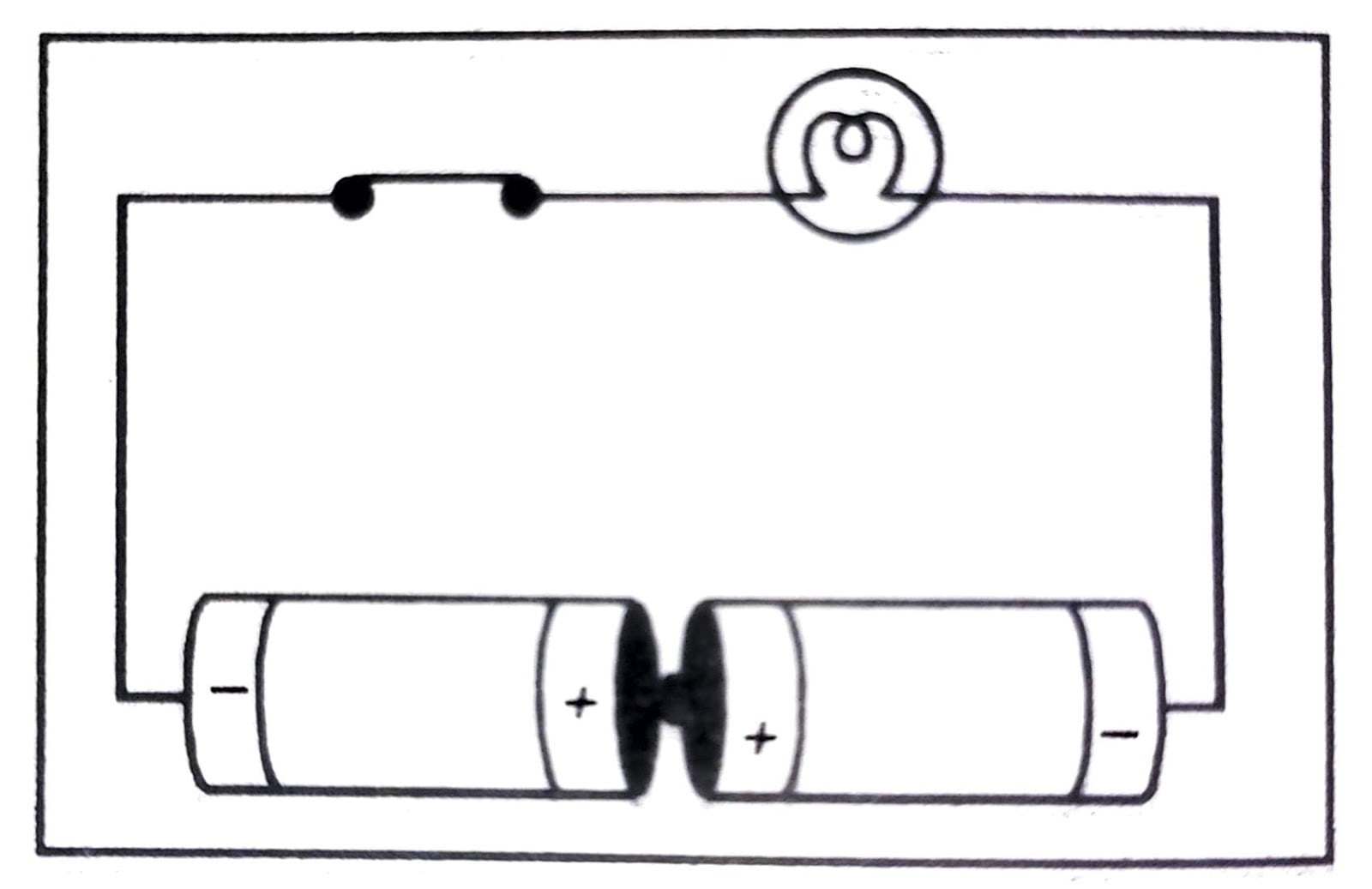
Fig. 14. 26.
Q. 5. Name any two effects currents.
Ans: Electric current has the following effect:
(i) Electric current can give rise to heating and lighting.
(ii) Electric current can make a straight conductor, a temporary magnet.
Q. 6. When the current is ‘switched on through a wire, a compass needle kept nearby gets deflected from its north-south position. Explain.
Ans: When current is passed through the wire, it deflects the compass near it from its north-south position behaving like a magnet. This is called magnetic effect of the current. As we know that needle of the compass is made up of a thin magnet, when this needle comes in contact with another magnet the like poles of the magnet repel each other and opposite poles attract each other. So the deflection is seen in the needle. In this case the wire behaves like a magnet and cause deflection in needle of the compass.
Q. 7. Will the compass needle show deflection when the switch in the circuit shown by Fig. 14.27 is closed?
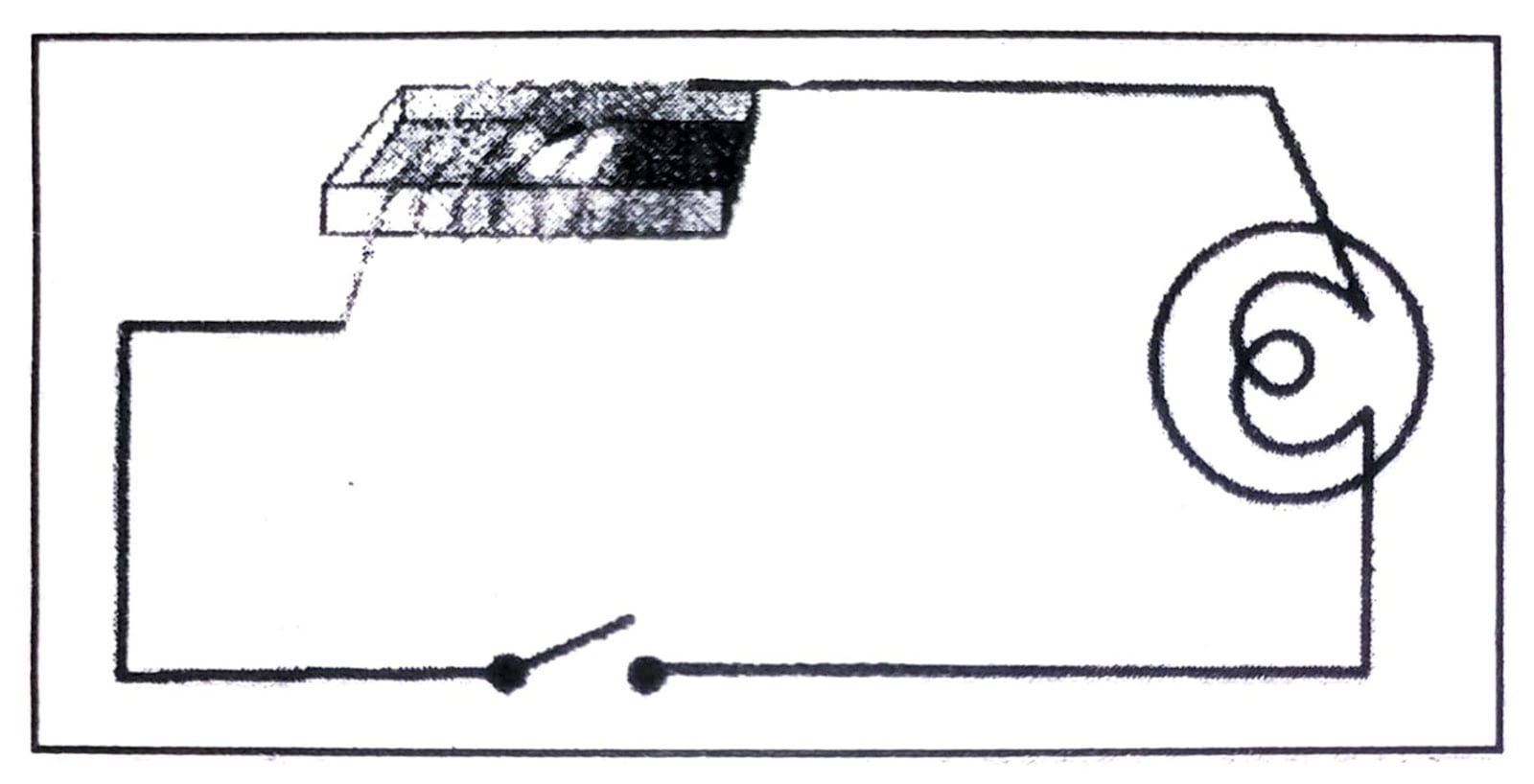
Fig. 14.27
Ans: No, because there is no source of electric current in this circuit i.e. there is no battery.
Q. 8. Fill in the blanks:
(a) Longer line in the symbols for a cell represents its _________ terminal.
Ans: Positive.
(b) The combination of two or more cells is called a _________.
Ans: Battery.
(c) When current is switched ‘on’ in a room heater, its _________.
Ans: Element becomes red hot and emits heat.
(d) The safety device based on the heating effect of electric current is called a _________.
Ans: Fuse.
Q. 9. Mark T if the statement is true and ‘F’ if it is false.
(a) To make a battery of two cells, the negative terminal of one cell is connected to the negative terminal of the other cell.
Ans: False.
(b) When the electric current through the fuse exceeds a certain limit, the fuse wire melts and breaks.
Ans: True.
(c) An electromagnet does not attract a piece of iron.
Ans: False.
(d) An electric bell has an electromagnet.
Ans: True.
Q. 10. Do you think an electromagnet can be used for separating plastic bags from a garbage heap? Explain.
Ans: No, the plastic bags do not get attracted by the magnet, so they cannot be separated by an electromagnet. Plastic bags are not magnetic materials, only magnetic materials like iron can be attracted by the magnet.
Q.11. An electrician is carrying out some repairs in your house. He wants to replace a fuse by a piece of a wire. Would you agree? Give reasons for your response.
Ans: No, we would not agree to allow to replace the fuse by a wire. Wires in the fuses are of specific melting points. So we should. always use ISI marked fuses in our houses to save short circuits.
Q. 12, Zubeda made an electric circuit using a cell holder shown in Fig. 14.28, a switch and a bulb. When she put the switch in the ‘ON’ position, the bulb did not glow. Help Zubeda in identifying the possible defects in the circuit.
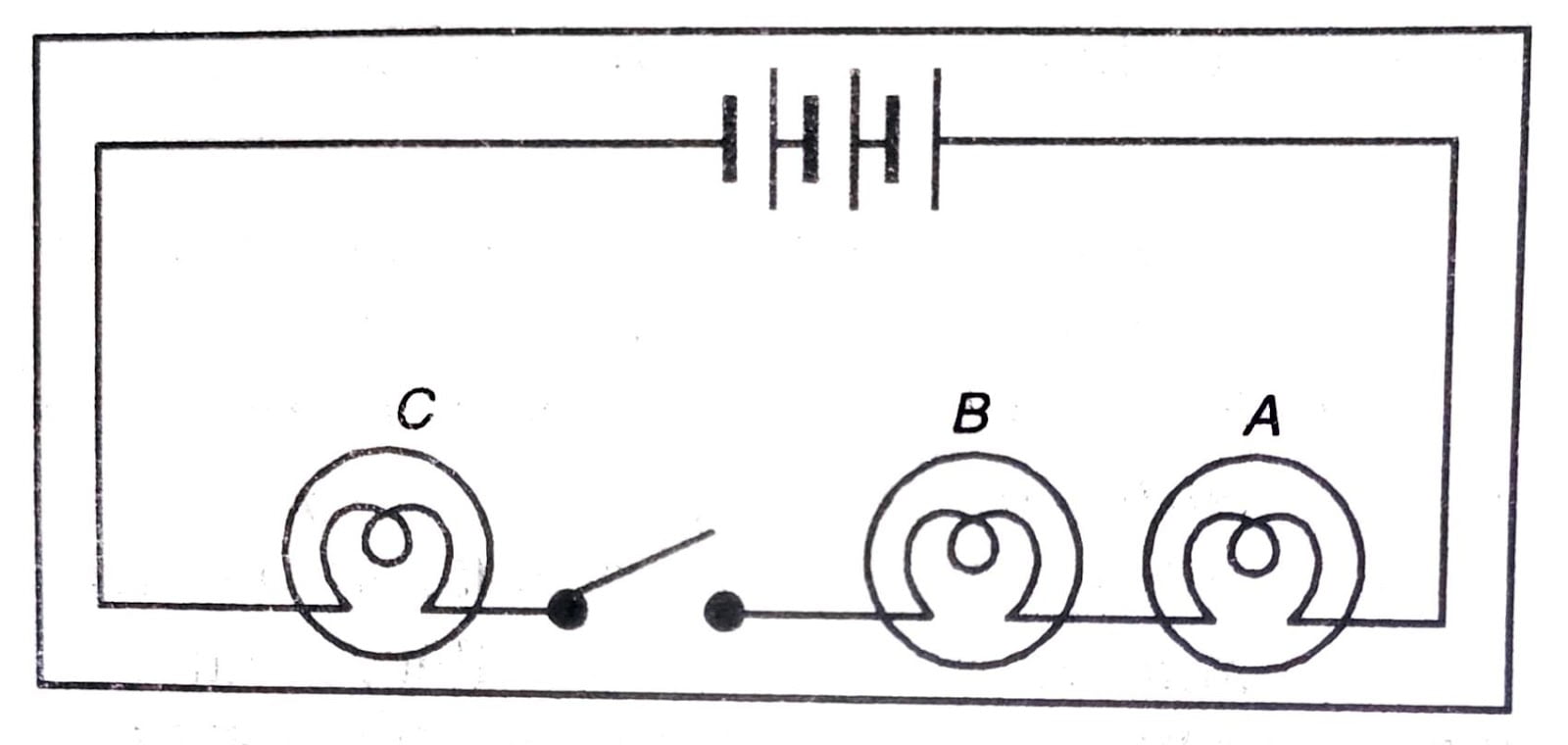
Fig. 14. 28.
Ans: It is important to put the cells in right series. The positive terminal of cell should be connected with negative terminal of the second cell. The switch should be closed properly and bulb should not be fused. If Zubeda will check these then the bulb will certainly glow.
ADDITIONAL IMPORTANT QUESTIONS
Very Short Type Questions Answer
Q. 1. Name the device which is used to ‘make’ or ‘break’ an electric circuit.
Ans: Switch.
Q. 2. Name the electrical components having the following symbols:

Ans: (a) Battery of two cells.
(b) Electric bulb.
Q. 3. Which effect of electric current is utilized.
(a) in an electric iron?
Ans: Heating effect.
(b) in an electric bulb?
Ans: Heating effect.
Q. 4. Name the alloy which is used to make the heating elements of electrical heating appliances like an electric iron.
Ans: Nichrome.
Q. 5. Name the metal which is used to make the filament of an electric bulb.
Ans: Tungsten.
Q. 6. Name the phenomenon which occurs:
(a) when the two naked wires of electricity supply line touch each other.
Ans: Short circuit.
(b) when too many electrical appliances are connected to a single socket.
Ans: Overloading.
Q. 7. What is the name of a safety device which cuts off the electricity supply during a short circuit:
(a) by turning off a switch?
Ans: Miniature circuit breaker (MCB).
(b) by breaking a thin wire?
Ans: Electric fuse.
Q.8. What name is given to the following arrangement: A coil is insulated copper wire wrapped around an iron piece and connected to an electric cell?
Ans: Electromagnet.
Q. 9. Name any two devices in which electromagnets are used.
Ans: Telephone instruments.
(b) Electric motors.
Q. 10. Which effect of electric current is utilized in an electric bell?
Ans: Magnetic effects.
Q. 11. How does a current carrying solenoid behave?
Ans: It behaves like a bar magnet.
Q. 12. In domestic electric circuit with which wire do we connect a fuse?
Ans: Fuse is connected with the live wire.
Q. 13. Which effect of electric current is utilized in the working of an electric fuse?
Ans: An electric fuse works on the heating effect of current.
Q. 14. What happens when a wire carrying electric current (D.C.) is placed near a magnetic needle?
Ans: The magnetic needle gets deflected.
Q. 15. Name two appliances made on the basis of the heating effect of current.
Ans: (i) Electric geyser.
(ii) Toaster.
Short Type Questions Answer
Q. 1. Why a copper wire cannot be used as a fuse wire?
Ans: A copper wire cannot be used as a fuse wire because it has a high melting point due to which it cannot melt by the heat produced by the excessive flow of current during a short circuit.
Q. 2. Differentiate between a closed circuit.
Ans: Closed electric circuit The electric path which starts from the positive terminal of a cell or battery ends at its negative terminal, without any break, is called a closed electric circuit.
Open electric circuit: The electric path which starts from the positive terminal of a cell or battery, is broken at some point, is called an open electric circuit.
Q. 3. What is an electromagnet? What does it consist of?
Ans: An electromagnet is a rod of magnetic material (say soft iron) placed inside a solenoid coil. On passing current in solenoid coil, iron rod begins to behave as a magnet. However, on stopping flow of current in solenoid coil, the iron rod loses its magnetism. Such a magnet is known as the electromagnet.
Q. 4. Consider the following materials:
Copper, Tungsten, Chromium, Aluminium, Nichrome, Iron.
Which of these is used to make
(a) heating element of an electric iron?
Ans: Nichrome.
(b) filament of an electric bulb?
Ans: Tungsten.
Q. 5. Of what substance is the fuse wire made? Why?
Ans: The fuse wire is usually made from tin- plated copper wire. The tin-plated copper wire has low melting point due to which it can melt by the heating caused by the excessive flow of current in the circuit.
Q. 6. What is meant by the heating effect of current? Name three appliances based on this effect.
Ans: The generation of heat in a resistor or conductor when electricity passes through it is called heating effect of current.
Appliances based on heating effect of current are water heaters, room heaters and toasters.
Q. 7. Two separate sets of two cells each shown below. Draw lines to indicate how you will connect their terminals with wires to make batteries of two cells each.
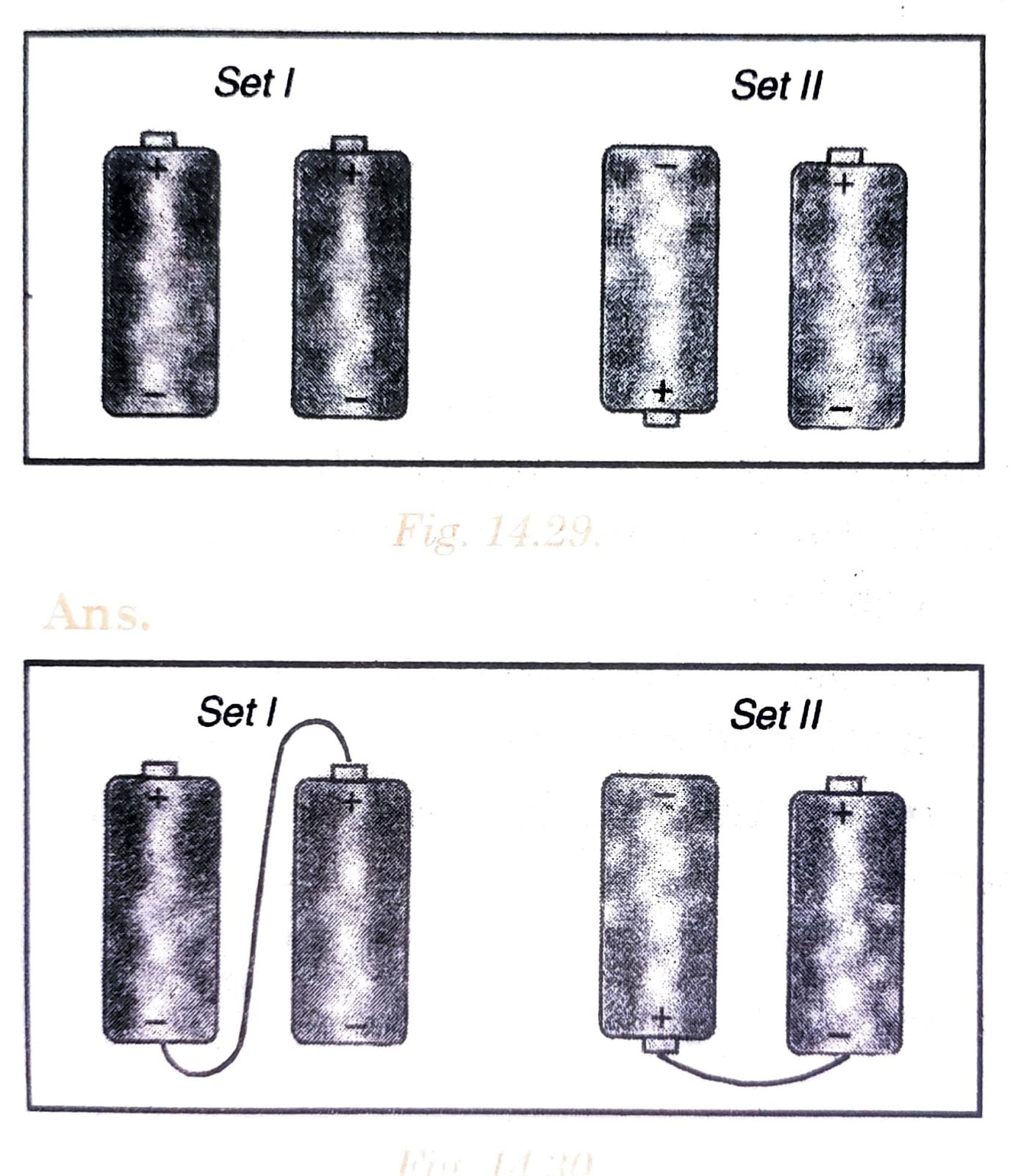
Fig. 14. 30.
Q. 8. Draw a complete electric circuit showing the path of the electric current.
Ans:

Fig. 14. 31.
A complete circuit showing path of electric current.
Q. 9. Mention two uses of electromagnets.
Ans. Uses of electro-magnets:
(i) Electromagnets are used in cranes, in steel works and scrapyards for lifting heavy loads.
(ii) In hospitals dealing with eye injuries, electro magnets are used for removing iron splinters from the eyes.
Q. 10. Give two reasons of excessive currents in our houses.
Ans. (i) Direct touching of wires: This may happen if the insulation on the wires has come off due to wear and tear. This may cause a short circuit.
(ii) Connection of many devices to a single socket: This may overload in the circuit.
Short Type Questions Answer
Q. 1. (a) What is an electromagnet? What does it consist of?
Ans: An electromagnet is an appliance which produces a magnetic field around its conductor coil on passing electric current through its coil.
It consists of a core of iron metal or its alloy and a solenoid conductor coil around the core.
(b) Name one material in each case which is used to make a:
(i) permanent magnet.
(ii) temporary magnet.
Ans: (i) Alnico alloy is used for making permanent magnets.
(ii) Soft iron metal is used for making temporary magnet.
Q. 2. Explain the principle on which an electric fuse works.
Ans: When an electric appliance is turned ON, the electric current first flows through the electric fuse before it reaches the electric appliance. If there is an excess flow of current, then a large amount of heat is produced. This heat causes the fuse wire to melt and thus break the circuit. This cuts off the supply of current to the electrical appliances. Thus, preventing any damage to the electrical appliances.
Q. 3. Write three factors on which the amount of heat produced by the electric iron depends.
Ans: (i) The length of the coil: The longer the coil, the greater is the heat produced.
(ii) The thickness of the coil: The thinner, the coil, more is the heat produced.
(iii) The material of the coil: Coil made of tungsten produces more heat than a coil made of copper.
Q. 4. Explain why, filament type electric bulbs are not power efficient. Name any two types of electric lighting devices which are much more energy efficient than filament type bulbs.
Ans: A major part of the electricity consumed by the filament of an electric bulb is converted into heat (due to which the bulb becomes hot), only a small part of electricity is converted into light. The production of heat by an electric bulb is not desirable because it leads to the wastage of electricity. So, the filament type electric bulbs are not power efficient because they waste a lot of electricity as heat.
Electric lighting devices which are much more energy efficient than filament type bulbs are fluorescent tube lights and compact fluorescent lamps (CFLs).
Q. 5. Write three differences between a barmagnet and an electromagnet.
Ans:
| Barmagnet | Electromagnet |
| 1. It s a permanent magnet. | 1. It is a temporary magnet. |
| 2. Its power cannot be changed. | 2. The power can be changed. |
| 3. Its uses are limited | 3. Its uses are more wide. |
Long Type Questions Answer
Q. 1. When is an electric circuit said to be over loaded? State two measures to avoid it. What name is given to a situation in which the live and the neutral wires accidently come in contact? State the role a safety device which may play in this situation.
Ans: Overloading: The current flowing in domestic wiring at a particular time depends on the power ratings of the appliances being used. If too many electrical appliances of high power rating are switched on at the same time, they draw an extremely large current from the circuit. This is known as overloading the circuit. Now, due to an extremely large current flowing through them, the copper wires of household wiring get heated to a very high temperature and a fire may be started.
Measures to avoid overloading:
(i) Many electrical appliances of high power rating should not be switched on at the same time.
(i) Too many appliances should not be connected to a single socket. Short circuiting is given to a situation in which the live and the neutral wires accidently come in contact.
Safety device is an electric fuse. When a short circuit takes place, or when overloading takes place, the current becomes large and heats the fuse wire too much. Since the melting point of fuse wire is much lower than copper wires, the fuse wire melts and breaks the circuit. When the fuse wire breaks, electricity supply is automatically switched off before any damage can be done to the rest of the wiring.
Q.2. Explain the construction and working of an electric bell with help of a labeled diagram.
Ans: An electric bell consists of an electromagnet, armature, contact spring, hammer and gong.
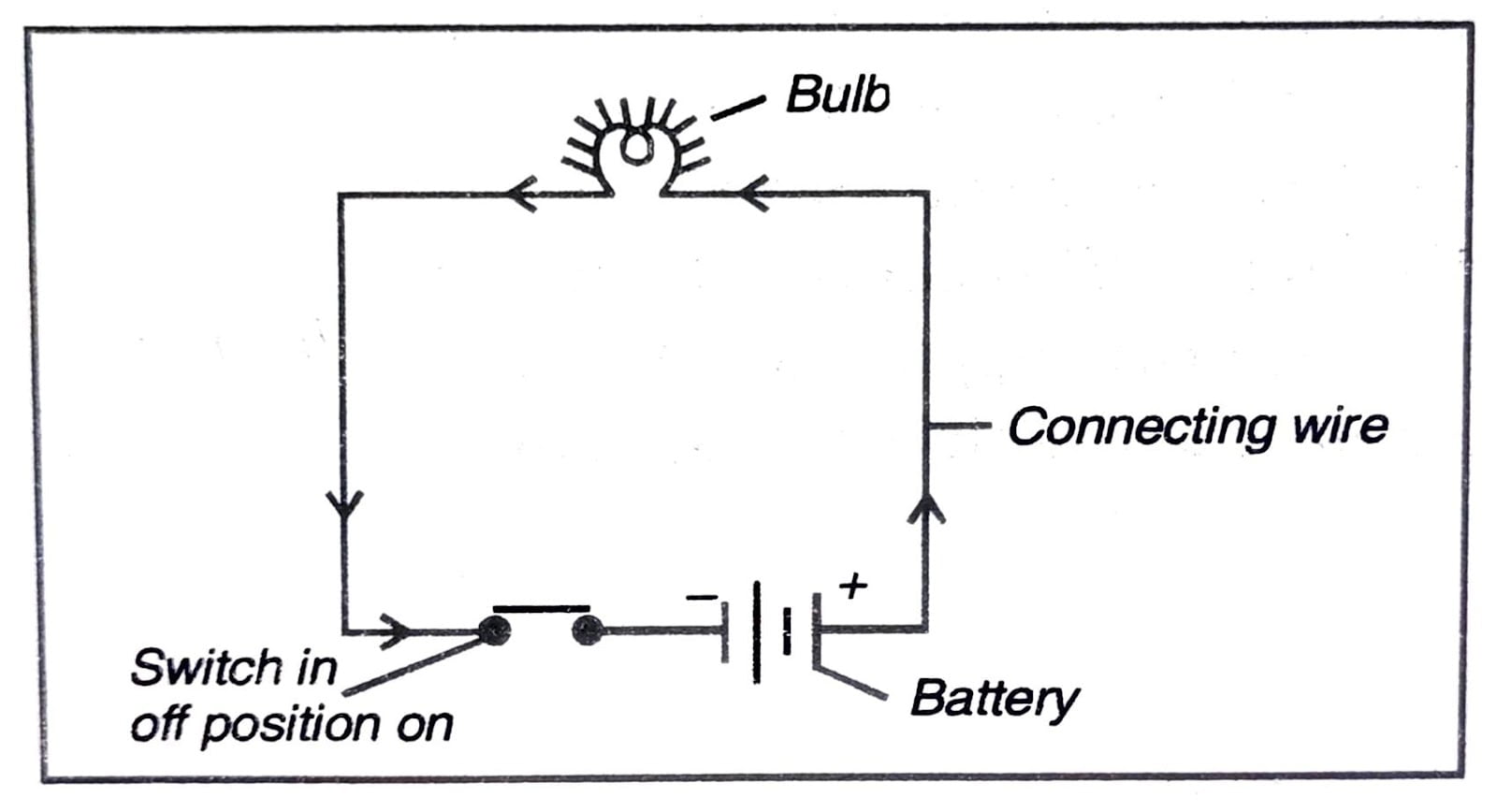
Electromagnet: It consists of a U-shaped soft iron rod having insulated copper wire wounded on it. One end of wire is connected to terminal T and other to the brass stud.
Armature is a soft iron rod, suspended to brass stud. It faces the poles of the electromagnet.
Contact spring is attached to the armature and to a silver-cadmium alloy contact point. Spring is made up of steel.
Contact screw adjustment: It is a brass pillar having a brass screw passing through it. The tip of the screw is made up of silver – cadmium alloy. Pillar is connected to T, with a copper wire.
Hammer and Gong: Hammer is made up of steel and is attached to the armature. Gong is made up of brass, and the hammer strikes the gong to make the sound.
Working: When electric current passes through T, and T, current passes from the battery to electromagnet, then to the contact screw and T, to T, completing the circuit. Electromagnet pulls the armature towards itself, the contact spring gets under tension, hammer strikes against gong thus making the sound. The whole process stops, when current stops flowing.
Q. 3. What is an electromagnet? Draw a labelled diagram to show how an electromagnet is made. What is purpose of the soft iron core used in making an electromagnet? Why steel is not used for making electromagnets?
Ans: The magnet made by using electric current is called an electromagnet. An electromagnet works on the magnetic effect of current.
An electromagnet consists of a long coil of insulated copper wire wound around an iron rod. When the two ends of the coil are connect to a cell, a current passes through the coil and produces a magnetic effect. The magnetic effect magnetizes the iron rod. So, the iron rod becomes an electromagnet. The magnetism of an electromagnet remains as long as the current is flowing in its coil. If we switch off the current in the coil (by opening the switch) all the magnetism of the iron rod disappears and it no longer behaves as a magnet.
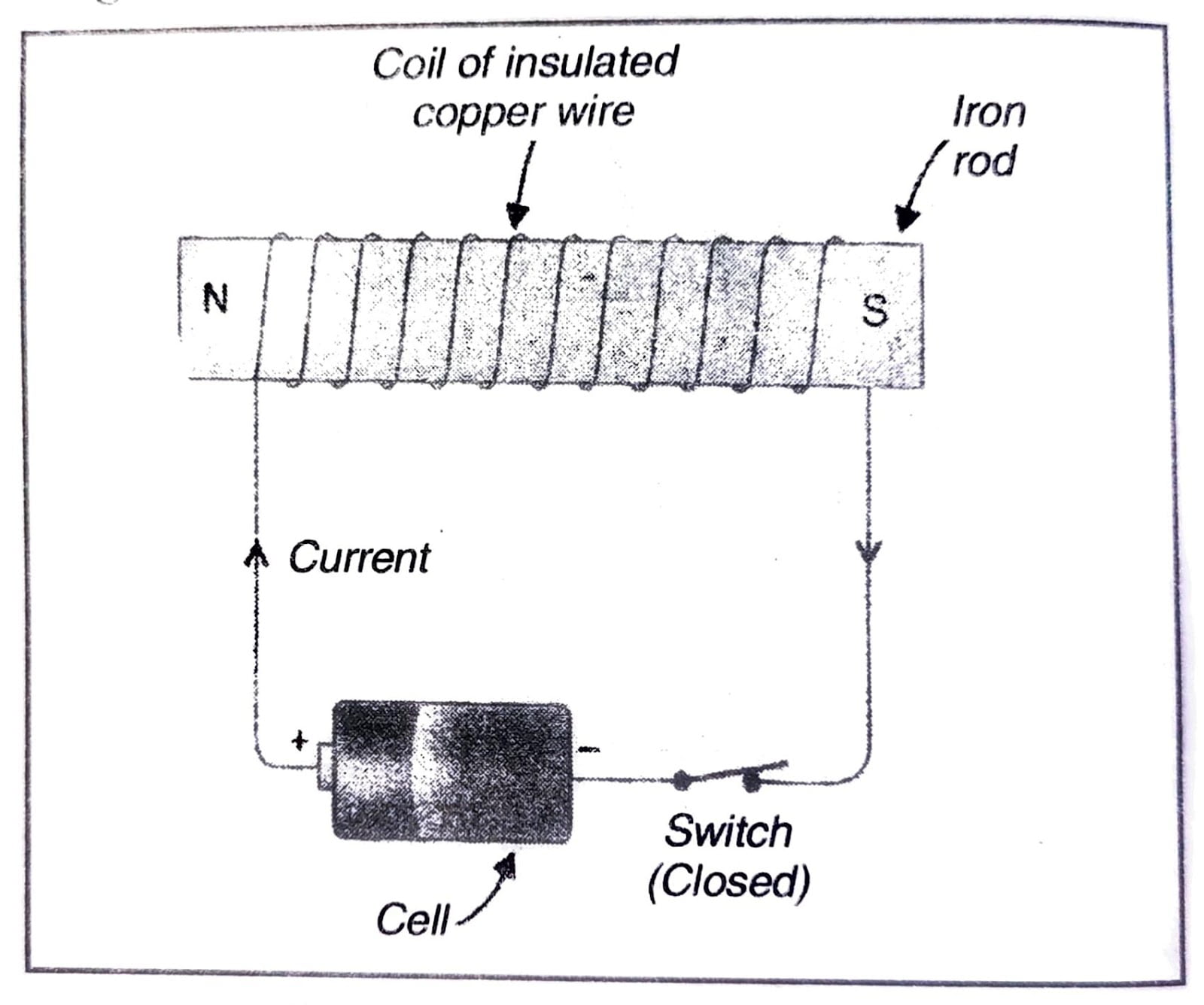
Fig. 14.33. An electromagnet.
So electromagnet is a magnet consisting of coil of insulated wire wrapped around a piece of iron that is magnetized only when electric current is passed through the coil.
Only iron is used for making electromagnets: This is because when current is switched off in the coil of an electromagnet made of iron piece, then the iron piece loses all its magnetism. Steel is not used for making electromagnets because when current is switched off from the coil of an electromagnet made of a steel piece, the steel piece does not lose all its magnetism. The steel piece retains the magnetism and becomes a permanent magnet.
HOTS QUESTIONS
Q.1. The bulbs in the circuit shown below does not glow. Identify the problem. Make necessary change in the circuit to make the bulb glow.
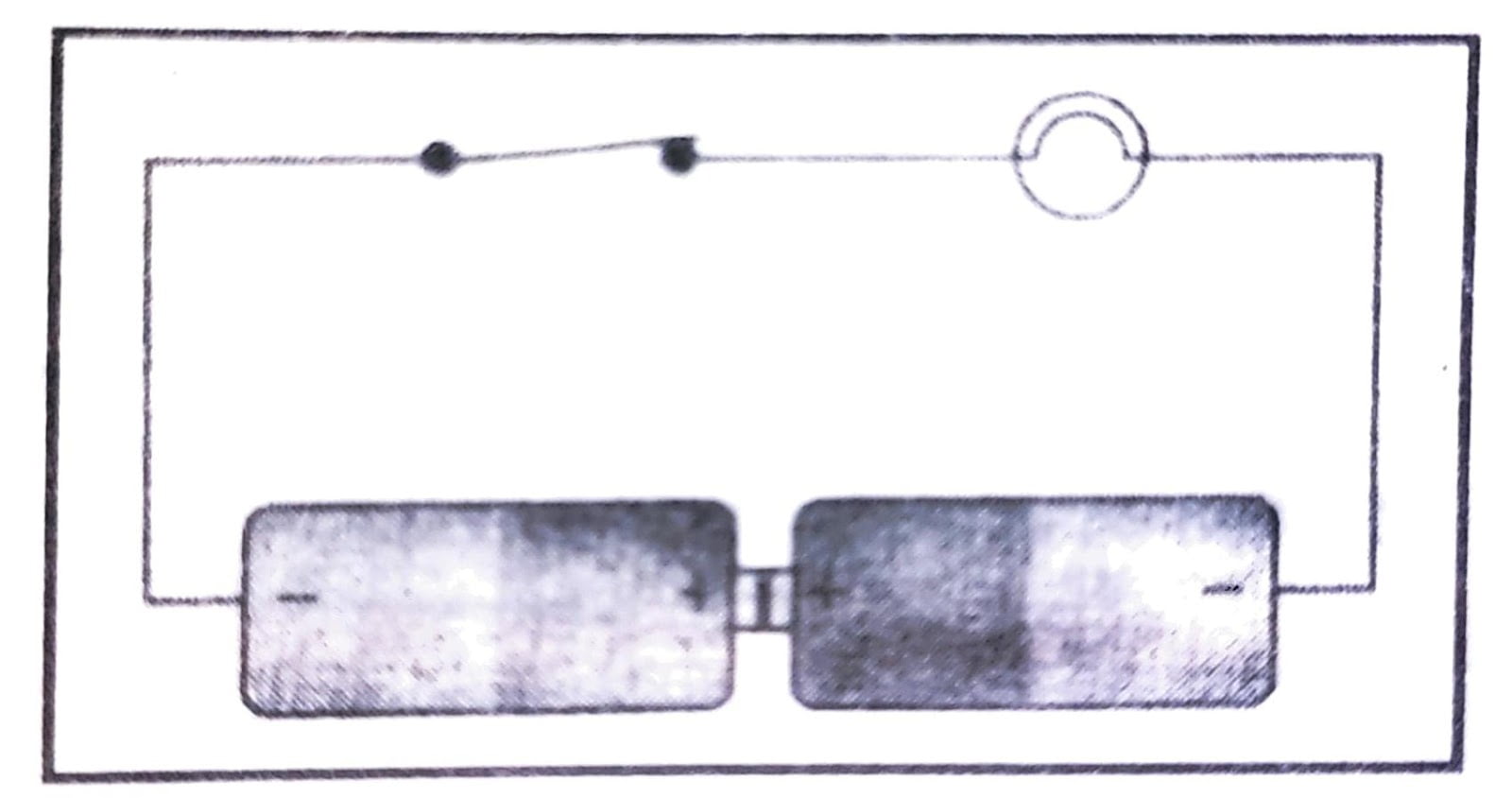
Fig. 14. 34.
Ans: Problem: The positive terminal of one cell is in touch with the positive terminal of the other cell.
Necessary changes: Keep the positive terminal of one cell in touch with the negative terminal of the other cell.
Q. 2. The figure given below shows four cells fixed on a wooden board. Draw lines to indicate how you will connect their terminals with wires to make a battery of four cells.
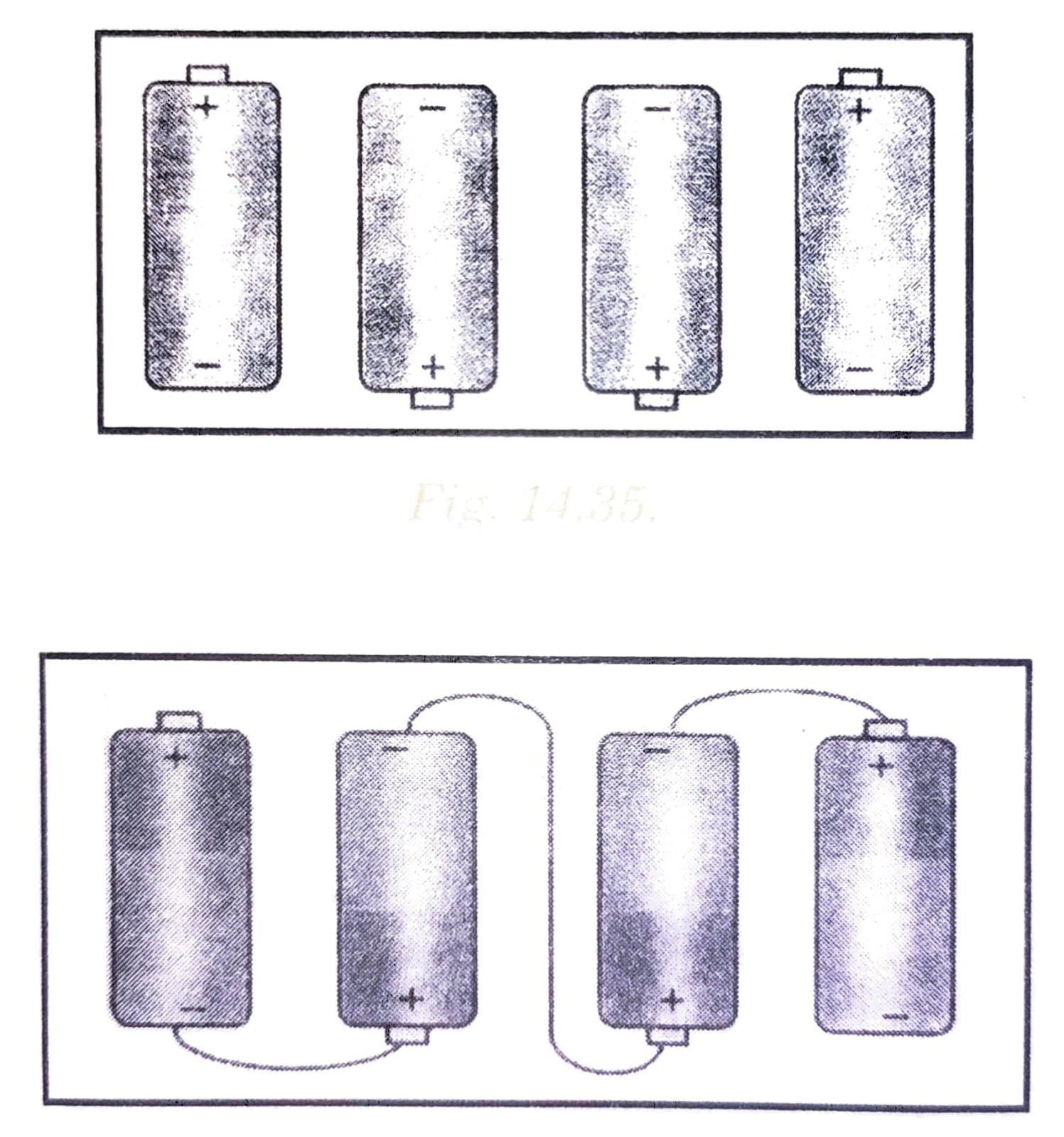
Fig. 14. 36.
Q. 3. (a) What is an electromagnet?
Ans: When a soft iron core is inserted into a solenoid conductor and current is passed through it, it behaves like a strong magnet. This arrangement is called an electromagnet.
(b) List any of its two uses.
Ans: (i) An electromagnet is used for making electric bell.
(ii) It is also used in the cranes to lift heavy iron objects.
(c) Draw a labeled diagram to show how an electromagnet is made.
Ans:
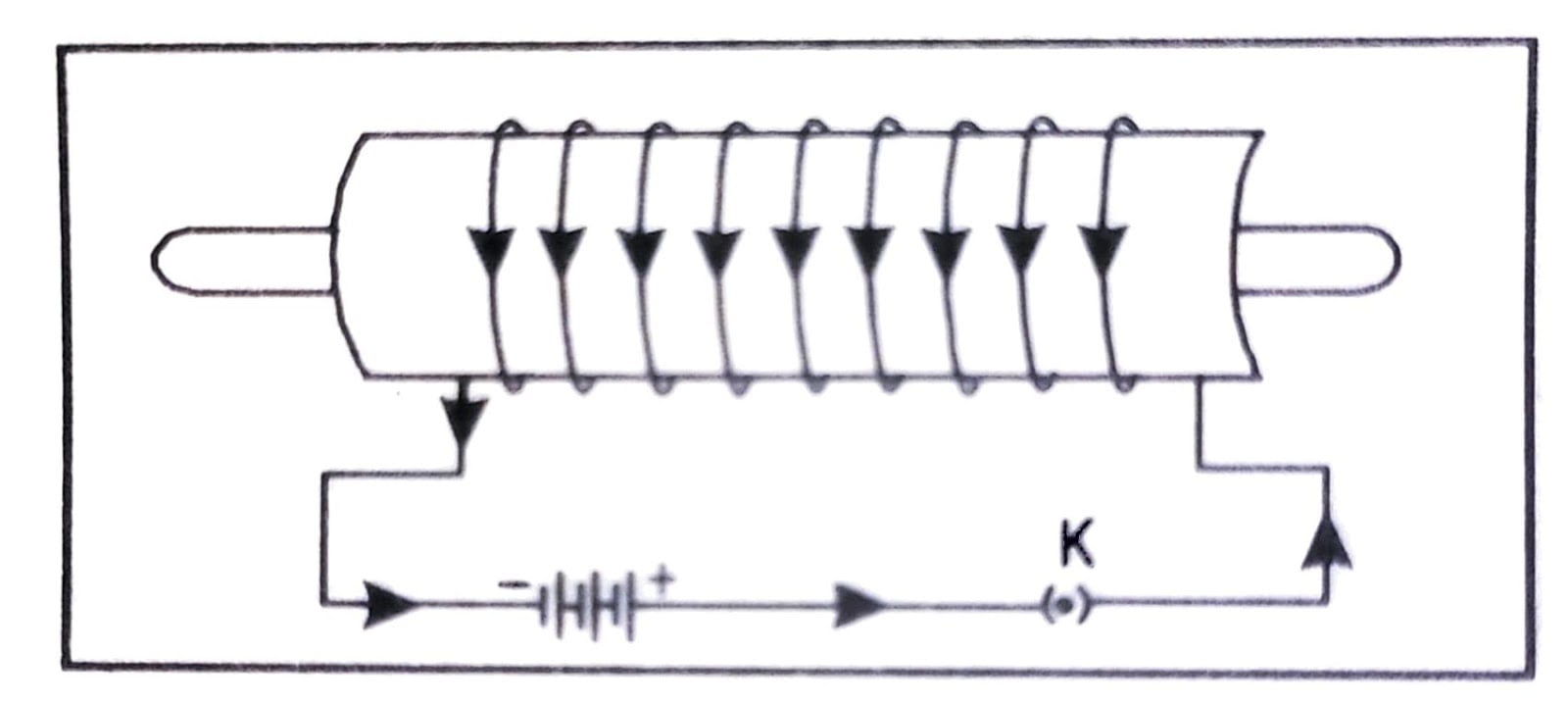
Fig. 14. 37.
(d),What is the purpose of soft iron core used in making an electromagnet?
Ans: Soft iron core is used to increase the strength of the electromagnet.
Q. 4. Draw the circuit of the following system showing the actual components (like cell, bulb, switch, etc.).

Ans:

SKILL BASED QUESTIONS
Q.1. Draw diagrams of a:
(i) closed circuit til open circuit. In which the bulb glows?
Ans:
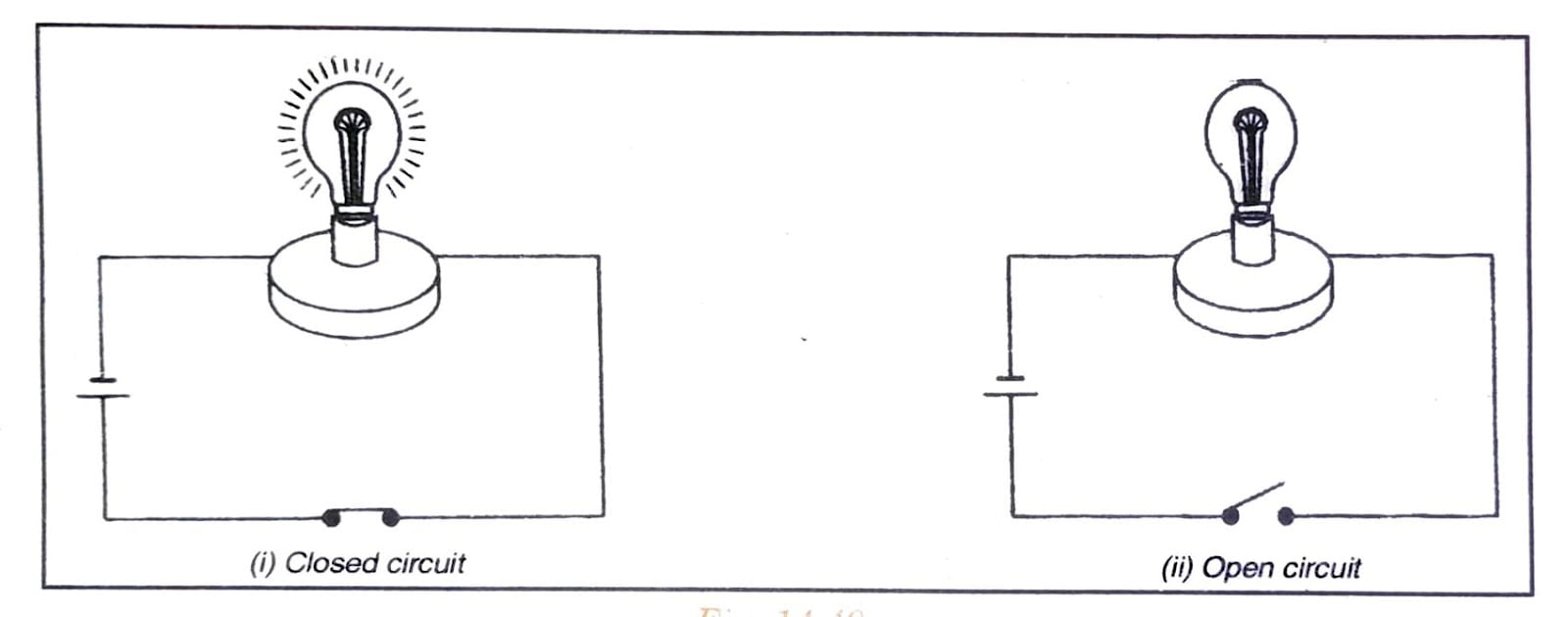
Fig. 14. 40.
The bulb glows on when the circuit is closed or switched ON.
Q. 2. Draw a diagram of an electric heater and name the element in it.
Ans:
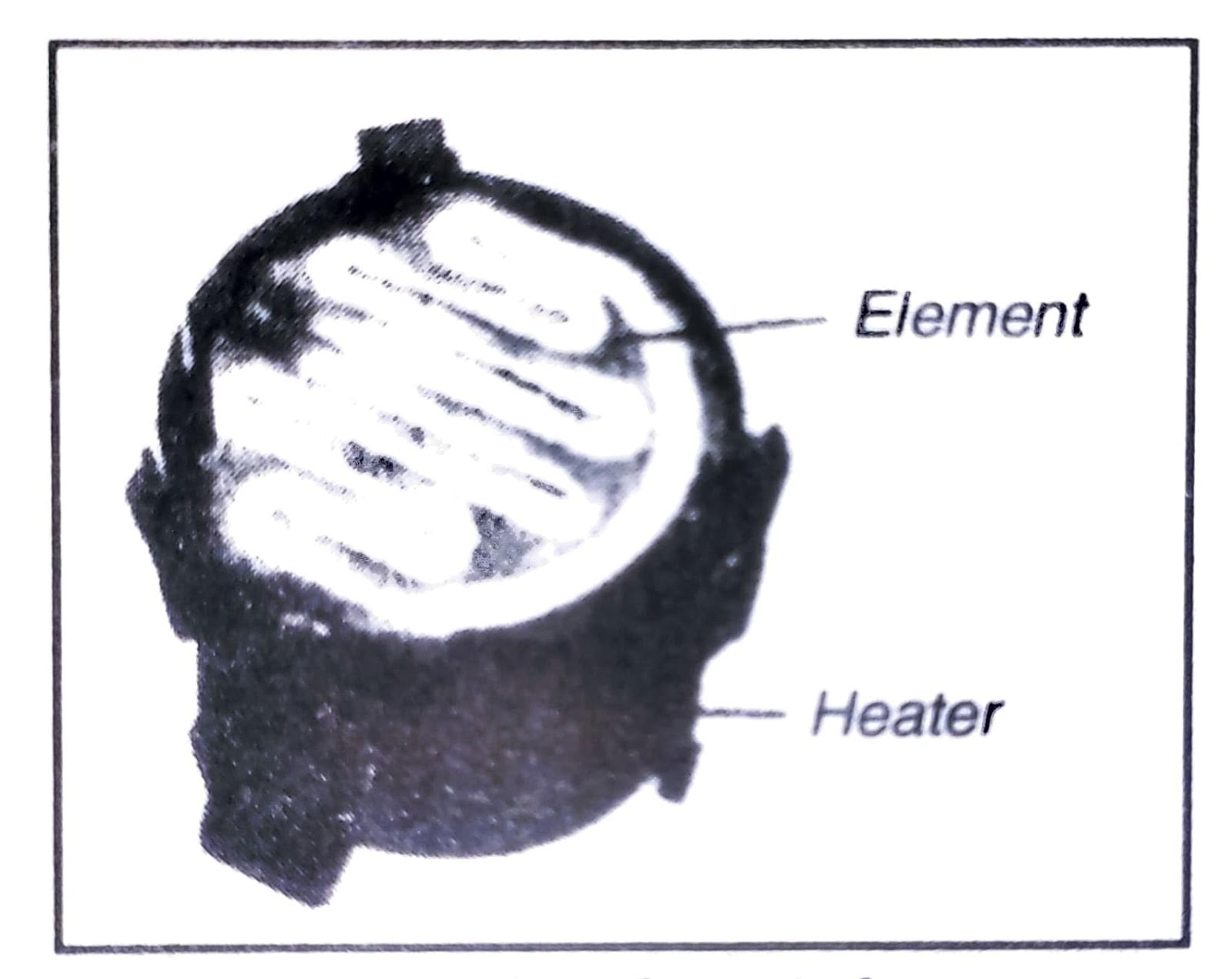
Fig. 14. 41. An electric heater.
Q .3. Draw a diagram of a glowing bulb and the glowing filament of it.
Ans:
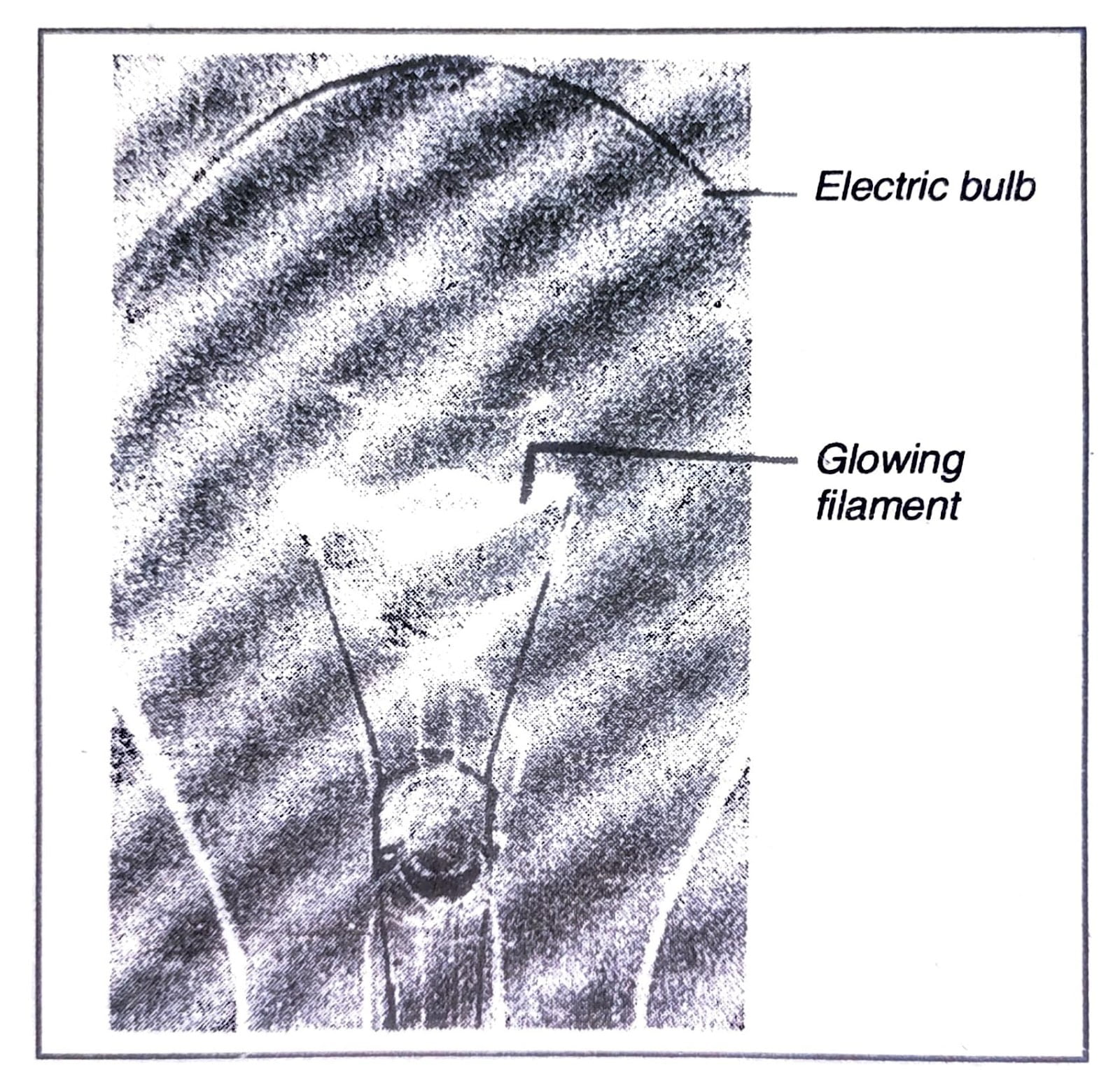
Fig. 14. 42. Glowing filament of an electric bulb.
FORMATIVE ASSESSMENT
1. Fill in the following blanks with suitable words:
(i) The conducting path through the bulb,
wires, switch and battery is called __________.
Ans: Electric circuit.
(ii) The magnet made by using electric current is called an ___________.
Ans: Electromagnet.
(iii) An electric current flowing in a wire produces a _________ effect.
Ans: Magnetic.
(iv) A current carrying coil of an insulated wire wrapped around a piece of iron is called __________.
Ans: Electromagnet.
(v) When an electric current is passed through a coil wrapped around an iron nail, the iron nail behaves like a ________.
Ans: Magnet.
(vi) A combination of ________ is called a battery.
Ans: Two or more cells.
(vii) Two cells connected in head to tail manner delivers _______ voltage.
Ans: Higher.
(viii) A thin wire of copper ________ be used as fuse in an electrical circuit.
Ans: Cannot.
2. State whether the following statements are true or false:
(i) A battery is made by connecting positive terminal of one cell with the positive terminal of the other cell.
Ans: False.
(ii) A compact fluorescent lamp (CFL) has a filament in it.
Ans: False.
(iii) MCB works on the heating effect of electric current.
Ans: False.
(iv) The heating element of an electric iron is made of tungsten.
Ans: False.
(v) Compact fluorescent lamp (CFL) works on the heating effect of current.
Ans: False.
(vi) An electromagnet is a temporary magnet.
Ans: True.
(vii) Electrical fuse is based on the magnetic effect of current.
Ans: False.
(viii) All electrical circuits always contain one dry cell.
Ans: False.
3. Match the following questions:
| Column – A | Column – B |
| 1. CFL | (a) A safety device to prevent circuit. |
| 2. ISI | (b) The wire used in heater to get heat. |
| 3. Switch | (c) Consume less energy than bulb. |
| 4. Fuse | (d) Appliance is safe to use. |
| 5. Element | (e) Turns the circuit ON or OFF. |
Ans:
| Column – A | Column – B |
| 1. CFL | (c) Consume less energy than bulb. |
| 2. ISI | (d) Appliance is safe to use. |
| 3. Switch | (e) Turns the circuit ON or OFF. |
| 4. Fuse | (a) A safety device to prevent circuit. |
| 5. Element | (b) The wire used in heater to get heat. |
4. Write one word for the following:
(i) The continuous path of flow of electricity through various components connected to a source of electricity.
Ans: Electrical circuit.
(ii) A diagram showing the arrangement of the various components of an electric circuit with the help of their symbols.
Ans: Circuit diagram.
(iii) A safety device which prevents damage to the electrical appliances.
Ans: Electric fuse.
(iv) An electromagnetic device used for lifting heavy loads.
Ans: Electromagnet.
(v) A household electrical device that is based on the magnetic effect of electric current.
Ans: Electric bell.
(vi) A piece of wire twisted to form a circle.
Ans: Coil.
(vii) A long cylindrical coil consisting of a large number of turns of an insulated wire.
Ans: Solenoid.
(viii) The weakest part in an electric circuit which results in melting and hence breaks an electric circuit in use.
Ans: Electric fuse.
5. Multiple Choice Questions:
(i) The most suitable material for making the core of an electromagnet is:
(a) iron
(b) brass
(c) aluminum
(d) steel
Ans: (a) iron.
(ii) Circuit Breaker Device which can be used in place of fuse in domestic electric wiring is called:
(a) CBD
(b) DCB
(c) MCD
(d) MCB
Ans: (d) MCB.
(iii) A current carrying wire produces:
(a) an electric field
(b) a magnetic field
(c) both electric and magnetic fields
(d) neither electric nor magnetic field
Ans: (b) a magnetic field.
(iv) The sound produced in a door bell is due to the:
(a) chemical effect of current
(b) heating effect of current
(c) magnetic effect of current
(d) none of the above
Ans: (c) magnetic effect of current.
(v) Which of the following characteristic is NOT suitable for a fuse wire?
(a) thin and short
(b) thick and short
(c) low melting point
(d) higher resistance than rest of wiring
Ans: (b) thick and short.

Hi! my Name is Parimal Roy. I have completed my Bachelor’s degree in Philosophy (B.A.) from Silapathar General College. Currently, I am working as an HR Manager at Dev Library. It is a website that provides study materials for students from Class 3 to 12, including SCERT and NCERT notes. It also offers resources for BA, B.Com, B.Sc, and Computer Science, along with postgraduate notes. Besides study materials, the website has novels, eBooks, health and finance articles, biographies, quotes, and more.



